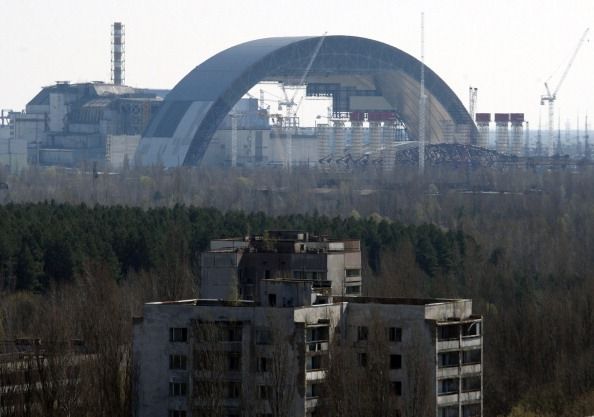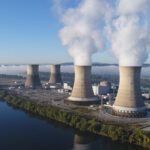Chernobyl’s sarcophagus, redux
By Dan Drollette Jr | May 5, 2014

On April 26, 1986, technicians at Unit 4 in Chernobyl, Ukraine, were conducting a test of their RBMK nuclear reactor when they inadvertently started a runaway reaction. Excess, superheated steam built up, the core was blasted open, and a huge plume of radioactive material wafted into the sky. The heat was so intense that it caused the nuclear fuel still in the plant to liquefy, where it mixed with other materials, such as concrete, and formed a lava-like material that flowed into the spaces below. At least 31 people died as an immediate result of the accident, and tens of thousands of people living nearby were evacuated.
To contain the radiation, the ruined reactor was hastily entombed. Several months after the accident, the destroyed reactor was completely covered with a concrete and steel shell called the sarcophagus. Authorities declared it would last "for eternity."
But “[t]he sarcophagus began cracking soon after it was built and must be strengthened or replaced. To complicate matters, the sarcophagus is also sinking into the earth, and the ground water is rather near the surface . . .” noted an article in the Bulletin of Atomic Scientists in September 1992. At that time, a Ukrainian parliament deputy, Vladimir Yavorivsky, called for ideas about what to do, announcing a competition among world scientists to come up with a solution to the failing tomb.
That was more than 28 years ago.
Now, finally, a multinational consortium is at the half-way point in building a huge, $1.5 billion, state of the art, all-stainless-steel hangar that will sit over the ruined remains of reactor Unit 4 like the world’s largest Quonset hut. Pictures in the New York Times show an immense and imposing structure whose construction is long overdue.
Tall enough to house the Statue of Liberty, the new, 32,000-ton hangar is being assembled a few hundred yards away from the still-radioactive site. Once it is finished, it will be rolled into place over the existing sarcophagus—which is starting to show its age. (A portion of the roof over the adjacent turbine collapsed last year, releasing a small amount of radiation.) Once in place, the new structure should contain radioactive dust, preventing any atmospheric contamination should the old sarcophagus collapse. The new building is expected to last anywhere from 100 to 300 years.
There is still some question as to what to do after the new cover is rolled into place and the site completely sealed up in 2017. Fuel is still contained amid the debris beneath the old sarcophagus; engineers are still undecided as to whether to remove it or leave it in place.
In any case, the new shell is only half-done, and there is concern about the effect that troubles in the eastern part of Ukraine will have on the construction project. Luckily, the Chernobyl region has not been affected by the political upheavals so far.
Readers of the May/June 1996 Chernobyl special issue of the Bulletin, however, will note that there are still a number of questions about what exactly happened in the early days of the aftermath of the Chernobyl explosion, when large numbers of “volunteers” (including former dissidents and political prisoners) were constructing the cobbled-together sarcophagus. No one really knows what went into the “concrete cube;” even the amount of concrete claimed to have been used is suspect, as it would form a volume larger than the sarcophagus, wrote nuclear engineer and author Alexander R. Sich in his 11-page article, “Truth was an early casualty.” Sich—a fluent speaker of Ukrainian and Russian, who lived in Ukraine for four years while earning his doctorate from MIT—was the first Western scientist to live and work with members of the Chernobyl Complex Expedition, a group of Russian and Ukrainian scientists studying the remains of reactor Unit 4.
Surprisingly, he felt that too much attention was paid to the sarcophagus itself, “which represented ‘victory’ over the accident.” Sich stated that more effort should have been focused on studying the reactor’s innards, the affected people, the local environment, and the effects of the radiation on the great swathes of afflicted agricultural land. “The Soviet leaders themselves wanted more than anyone else to believe that most of the contamination was contained within the sarcophagus, and so the stage was set for the creation of a myth that would remain unquestioned for several years,” Sich wrote.
“One of the terrible ironies of Chernobyl is that the world’s worst nuclear-power accident has been so thinly investigated. If an accident similar to Chernobyl had occurred in France, for example, the entire nuclear-energy world would have engaged its experts in studying the accident, limiting its consequences, and learning its lessons. In contrast, at Chernobyl, only 30 or so dedicated scientists struggle to find enough gasoline to drive to the reactor where they risk their lives to make their measurements.”
Together, we make the world safer.
The Bulletin elevates expert voices above the noise. But as an independent nonprofit organization, our operations depend on the support of readers like you. Help us continue to deliver quality journalism that holds leaders accountable. Your support of our work at any level is important. In return, we promise our coverage will be understandable, influential, vigilant, solution-oriented, and fair-minded. Together we can make a difference.
Topics: Analysis, Nuclear Energy















